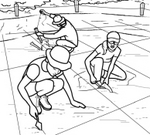
Worksheets and No Prep Teaching Resources
Reading Comprehension Worksheets
Fossils
Rocks and Minerals

Fossils
 Worksheets and No Prep Teaching Resources Reading Comprehension Worksheets Fossils Rocks and Minerals |
 Fossils |
| edHelper's suggested reading level: | grades 7 to 8 | |
| Flesch-Kincaid grade level: | 7.22 |
|
Fossils
By Sharon Fabian |

|
 1 Fossil hunters put on some old work clothes and gather up a few old-fashioned tools such as pry bars, chisels, hammers, and brushes. Then they head out to an abandoned stone quarry. Why? They're on the trail of trilobites.
1 Fossil hunters put on some old work clothes and gather up a few old-fashioned tools such as pry bars, chisels, hammers, and brushes. Then they head out to an abandoned stone quarry. Why? They're on the trail of trilobites. |
Create Weekly Reading Books
Prepare for an entire week at once! |
| Leave your feedback on Fossils (use this link if you found an error in the story) |
 |
Fossils
|
 |
Rocks and Minerals
|
 |
Science
|